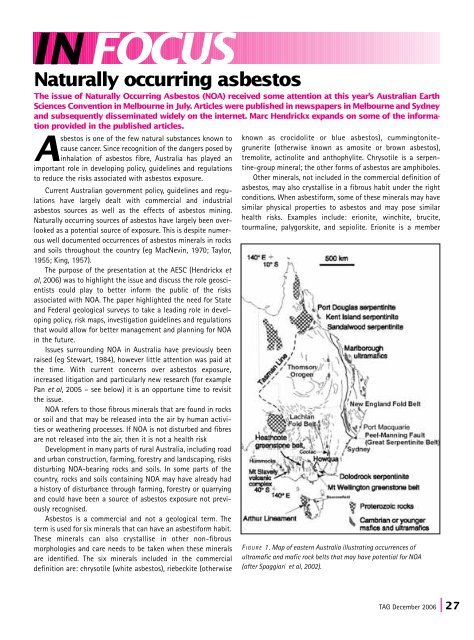The Australian Geologist - Geological Society of Australia
The Australian Geologist - Geological Society of Australia
The Australian Geologist - Geological Society of Australia
You also want an ePaper? Increase the reach of your titles
YUMPU automatically turns print PDFs into web optimized ePapers that Google loves.
IN FOCUS<br />
Naturally occurring asbestos<br />
<strong>The</strong> issue <strong>of</strong> Naturally Occurring Asbestos (NOA) received some attention at this year’s <strong><strong>Australia</strong>n</strong> Earth<br />
Sciences Convention in Melbourne in July. Articles were published in newspapers in Melbourne and Sydney<br />
and subsequently disseminated widely on the internet. Marc Hendrickx expands on some <strong>of</strong> the information<br />
provided in the published articles.<br />
Asbestos is one <strong>of</strong> the few natural substances known to<br />
cause cancer. Since recognition <strong>of</strong> the dangers posed by<br />
inhalation <strong>of</strong> asbestos fibre, <strong>Australia</strong> has played an<br />
important role in developing policy, guidelines and regulations<br />
to reduce the risks associated with asbestos exposure.<br />
Current <strong><strong>Australia</strong>n</strong> government policy, guidelines and regulations<br />
have largely dealt with commercial and industrial<br />
asbestos sources as well as the effects <strong>of</strong> asbestos mining.<br />
Naturally occurring sources <strong>of</strong> asbestos have largely been overlooked<br />
as a potential source <strong>of</strong> exposure. This is despite numerous<br />
well documented occurrences <strong>of</strong> asbestos minerals in rocks<br />
and soils throughout the country (eg MacNevin, 1970; Taylor,<br />
1955; King, 1957).<br />
<strong>The</strong> purpose <strong>of</strong> the presentation at the AESC (Hendrickx et<br />
al, 2006) was to highlight the issue and discuss the role geoscientists<br />
could play to better inform the public <strong>of</strong> the risks<br />
associated with NOA. <strong>The</strong> paper highlighted the need for State<br />
and Federal geological surveys to take a leading role in developing<br />
policy, risk maps, investigation guidelines and regulations<br />
that would allow for better management and planning for NOA<br />
in the future.<br />
Issues surrounding NOA in <strong>Australia</strong> have previously been<br />
raised (eg Stewart, 1984), however little attention was paid at<br />
the time. With current concerns over asbestos exposure,<br />
increased litigation and particularly new research (for example<br />
Pan et al, 2005 – see below) it is an opportune time to revisit<br />
the issue.<br />
NOA refers to those fibrous minerals that are found in rocks<br />
or soil and that may be released into the air by human activities<br />
or weathering processes. If NOA is not disturbed and fibres<br />
are not released into the air, then it is not a health risk<br />
Development in many parts <strong>of</strong> rural <strong>Australia</strong>, including road<br />
and urban construction, farming, forestry and landscaping, risks<br />
disturbing NOA-bearing rocks and soils. In some parts <strong>of</strong> the<br />
country, rocks and soils containing NOA may have already had<br />
a history <strong>of</strong> disturbance through farming, forestry or quarrying<br />
and could have been a source <strong>of</strong> asbestos exposure not previously<br />
recognised.<br />
Asbestos is a commercial and not a geological term. <strong>The</strong><br />
term is used for six minerals that can have an asbestiform habit.<br />
<strong>The</strong>se minerals can also crystallise in other non-fibrous<br />
morphologies and care needs to be taken when these minerals<br />
are identified. <strong>The</strong> six minerals included in the commercial<br />
definition are: chrysotile (white asbestos), riebeckite (otherwise<br />
known as crocidolite or blue asbestos), cummingtonitegrunerite<br />
(otherwise known as amosite or brown asbestos),<br />
tremolite, actinolite and anthophylite. Chrysotile is a serpentine-group<br />
mineral; the other forms <strong>of</strong> asbestos are amphiboles.<br />
Other minerals, not included in the commercial definition <strong>of</strong><br />
asbestos, may also crystallise in a fibrous habit under the right<br />
conditions. When asbestiform, some <strong>of</strong> these minerals may have<br />
similar physical properties to asbestos and may pose similar<br />
health risks. Examples include: erionite, winchite, brucite,<br />
tourmaline, palygorskite, and sepiolite. Erionite is a member<br />
F IGURE 1. Map <strong>of</strong> eastern <strong>Australia</strong> illustrating occurrences <strong>of</strong><br />
ultramafic and mafic rock belts that may have potential for NOA<br />
(after Spaggiari et al, 2002).<br />
TAG December 2006 | 27

















